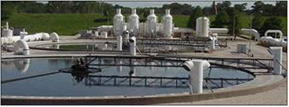
Odors occur as a natural part of the treatment of wastewater received at the Village Creek Water Reclamation Facility. By design, odors are usually contained within the plant site. However, due to a variety of operating and weather conditions, odors will occasionally drift away from the facility.
Most of the odors detected at a wastewater treatment plant have a rotten egg smell that indicates the presence of sulfur and it may include hydrogen sulfide and mercaptans. Other odors are characterized as fishy or pungent and may include materials containing ammonia (amines). All of these compounds are naturally occurring and are detectable by the human nose at extremely low concentrations.
Several processes are used by the Village Creek Water Reclamation Facility to minimize or eliminate odors:
- Source elimination. Monitoring of industrial and commercial facilities to minimize the discharge odor causing substances at their source
- Chlorine injection at the headworks. Chorine is added to the wastewater as it enters the treatment plant to reduce bacterial growth and neutralize odors.
- Covers over the weirs on the primary clarifiers. At some stages of the water treatment process, there is a significant amount of turbulence that can result in the release of odor causing agents. Permanent covers for these turbulent areas have been constructed to keep these odors from being released into the atmosphere.
- Enclosed buildings. Many of the processes at the treatment plant are performed inside of closed buildings. Air from these buildings is then scrubbed before it is released into the environment.
- Scrubbers. Air that is trapped under the covers of turbulent processes is pumped through a series of chemical and water solutions. These solutions trap or scrub the odor causing agents and prevent them from being released into the atmosphere.
- Biofilters. Foul air from some of the treatment processes is captured and percolated through a series of innovative biofilters that use microorganisms to remove odor causing agents.
- Capturing and burning biogas. Methane, produced from the bio-degradation of sludge, is captured and burned on-site to eliminate odors and to provide electricity used to operate a large portion of the treatment facility.
- Off-site treatment and beneficial reuse of biosolids. Biologically digested solids that result from various processes within the treatment plant are pumped to an off-site facility where they are dewatered in an enclosed building. The solids are then lime stabilized to reduce pathogens and to repel potential vectors. The wastes are then hauled by truck to agricultural districts in surrounding counties where the material is used for fertilizer and soil enhancers. This practice avoids the use of large, open-air lagoons and drying beds thereby significantly reducing odors to nearby neighborhoods.
Contact Information to report treatment plant odors:
Chief Operator Village Creek Water Reclamation Facility 4500 Wilma Lane Fort Worth , Texas 76012 817-392-4900
The operator will request the following information that will be used to determine the possible cause of the odor, and to develop corrective actions:
- Your name, address, and phone number Information regarding the complaint, such as:
- Where you observed the odor;
- The time you noticed it;
- Weather conditions at the time;
- Is it still noticeable;
- A description of the odor, and;
- How strong or persistent it is.
Tips for Reducing Household Sewer Odors:
- The ‘P” trap under every sink, tub, and floor drain, acts as a vapor barrier to keep sewer odors from coming back into your house. Normal use of appliances will keep these traps full of water to maintain their effectiveness.
- Ensure all plumbing connections have an appropriate “P” trap.
- Periodically run water through drains that aren’t used often, such as floor drains in restrooms or garages.
- When sinks or other appliances with drains to the sewer are removed, make sure all drain lines are properly capped. This may require a professional plumber and a City Permit to ensure that the job is done properly.
- Make sure all plumbing vents go outside the building. Standard plumbing, in accordance with adopted City Code, will ensure proper venting.
- Make sure that vent stacks are not obstructed by nesting birds or insects, and that vents are not cracked or improperly capped.
- Smoke testing by a qualified contractor may be needed to determine if the vent system in your business or home is working properly.